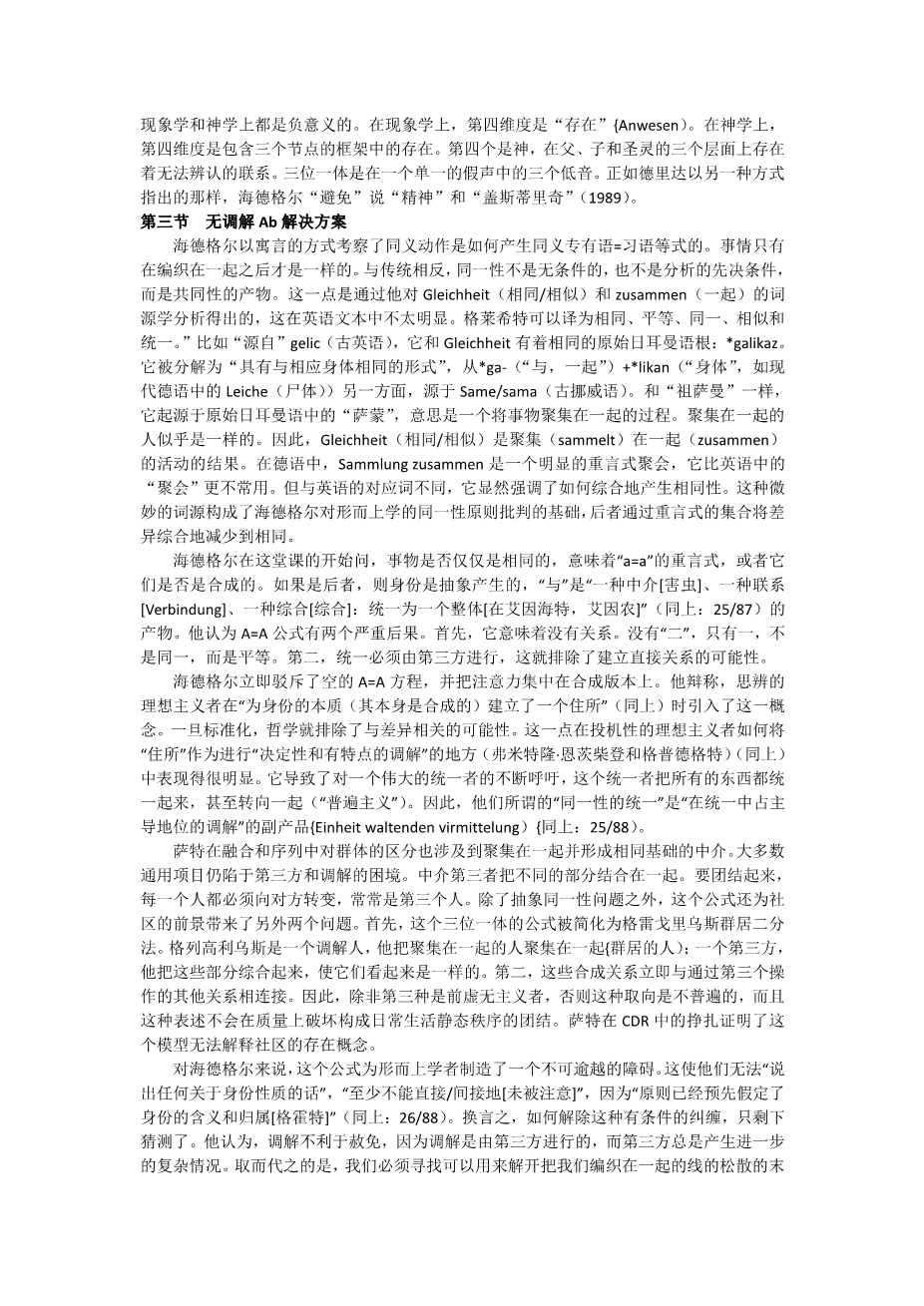农村集中居住问题与对策分析外文翻译资料
2022-08-06 09:51:15
From Containing Community p47-54
d) Com-unity, Immanence amp; Presence
Immanence and identity are traditionally treated as primary qualities of community. Community acts as a metaphorical house that shelters people together; communal identity is only shared amongst those who form a part of the whole. This communal fortress is impenetrable from the outside and inescapable from the inside. It is so exclusionary that strangers are unwelcome. Its centripetal forces are also so powerful that internal changes are rare. The only escape from this community is defection and/or ex-communication.
There is a slight misunderstanding in how this narrative is formulated, which Heidegger helps to clarify. It implies that community is a static entity. Centripetality is mistakenly treated as a simple magnetism that holds each of its components together. Traditionally, this means that there is neither activity, nor passivity, but only pure staticity; however, staticity is a state that must be constantly reinforced. We cannot just write this off as the work of mythology, an imaginary union, or symbolic identity because something more profound is occurring. The centripetal sweeping movements are as magnetic as they are magnificent. Com-unity is maintained by constantly gathering and re-gathering the parts together. Containing community is a constant activity. It works by preventing any significant part from transcending the whole altogether. To be at home in this containment—to be content and satisfied with, and thereby merely immanent to, this process—is to ignore its very activity. I draw this lesson from Heideggers disruption of the framework that holds us together. It is a disruption of immanence.
Heideggers most popular statement on this theme is his 'Letter' (1993a). It is written as a response to Sartres claim that 'existentialism is a humanism'. Sartre, argues Heidegger, replicates metaphysical principles and axioms {Ibid.: 222). Sartre apotheosizes humanity when he argues that 'man' is the 'lord', rather than Heideggers 'shepherd', of Being. In our terms, Sartre immanentizes 'ek-sistence', i.e. he grounds and thereby prevents the possibility of leaping out from the hypostasis. His notion of 'existence' is drawn from the banal, ontic, or factical reduction of existence qua 'actuality', which is contrasted to 'essence' as 'possibility'. Finally, Heidegger humiliates Sartre by pointing out that his dictum 'existence precedes essence' is merely a 'reversal of a metaphysical statement [so it] remains a metaphysical statement' (italics added, Ibid.: 232). To disrupt immanence, it must be transversed, not reversed.
Heideggers notion of ontological difference parenthetically concerns theological difference. The en-hypostatic formula identifies, immanentizes, and thereby annuls difference. Heidegger searches for a pathway where we can relate with the phenomenon of difference without reducing it to sameness. Phenomenologically, he transverses immanence by appealing to 'presence'. Theologically, he transverses the en-hypostatic formula by appealing to the an-hypostatic formula. For example, in the lecture on identity he argues that Ereignis is not Being per se, i.e. ousia/essentia, but the pathway through which Being is presence, i.e. parousia/prcesentia. This movement is both theologically and phenomenologically significant precisely because it is insignificant.
In his lecture on Hegel entitled 'On the Onto-Theo-Logical Constitution of Metaphysics', which he delivered just before the lecture on identity, Heidegger deals with theological insignificance (2002b). Heidegger critiques scientism, either as the 'science of God' (theology) or as the 'science of Being' (ontology), for immanentizing its subject (God or Being) {Ibid.: 59/126). He argues that the transcendenceimmanence dichotomy must be replaced by a transcendence-presence dichotomy (2002b: 67/135). This alternative dichotomy could open us to 'Difference as Difference' {Differenz als Differenz) {Ibid.: 47/113). 'The god-less thinking which must abandon the god of philosophy', which is the 'god as causa sui, is thus perhaps closer to the divine God'. This 'only says: It is freer for Him, than the onto-theo-logic would like to believe' {Ibid.: 72/141). One cannot anticipate how 'this step of thought will unfold itself into a proper (exerted in the Ereignis) pathway and course and constructedroad' {Ibid.). Furthermore, because the 'It' in 'It gives/there is' (Es gibf) is merely an active presence, one is incapable of appropriating or hypostatizing It. Presencing— which is also the space where the decisiveness of difference is presence—disrupts the presentation-representation schema that metaphysical theologians use to immanentize onto(-theo)-logical difference.
His argument that modern theology and humanism become indistinguishable through the horizon of immanence is not novel. Most theorists who draw from Heidegger are usually quite selective when applying this strain because it is mythopoetic, romantic, and conservative. The best example is his notion of the 'fourth dimension'. God, he argues, is beyond presentation-representation, past, present, and future, because 'proper [eigentliche] time is four-dimensional' (1972: 15/16). On the surface, 'actual', 'lived', and 'experienced' time is four-dimensional; yet it also means that the proper of time is the fourth-dimension. The fourth dimension is both phenomenologically and theologically—in their negative senses—(in)significant. Phenomenologically, the fourth dimension is 'presence' {Anwesen). Theologically,the fourth dimension is presence in the framework that contains the three nodal points. The fourth is God, the unidentifiable nexus presence in the three-fold of the Father, Son and the Holy Spirit. The Trinity is the three hypostases within a singular parousia. Heidegger, as Derrida notes in a different vein, 'avoided' saying 'Spi
剩余内容已隐藏,支付完成后下载完整资料


英语译文共 3 页,剩余内容已隐藏,支付完成后下载完整资料
资料编号:[255146],资料为PDF文档或Word文档,PDF文档可免费转换为Word




